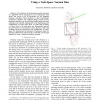Free Online Productivity Tools
i2Speak
i2Symbol
i2OCR
iTex2Img
iWeb2Print
iWeb2Shot
i2Type
iPdf2Split
iPdf2Merge
i2Bopomofo
i2Arabic
i2Style
i2Image
i2PDF
iLatex2Rtf
Sci2ools
ICRA
2009
IEEE
2009
IEEE
Path planning in 1000+ dimensions using a task-space Voronoi bias
— The reduction of the kinematics and/or dynamics of a high-DOF robotic manipulator to a low-dimension “task space” has proven to be an invaluable tool for designing feedback controllers. When obstacles or other kinodynamic constraints complicate the feedback design process, motion planning techniques can often still find feasible paths, but these techniques are typically implemented in the high-dimensional configuration (or state) space. Here we argue that providing a Voronoi bias in the task space can dramatically improve the performance of randomized motion planners, while still avoiding non-trivial constraints in the configuration (or state) space. We demonstrate the potential of task-space search by planning collision-free trajectories for a 1500 link arm through obstacles to reach a desired end-effector position.
| Added | 23 May 2010 |
| Updated | 23 May 2010 |
| Type | Conference |
| Year | 2009 |
| Where | ICRA |
| Authors | Alexander C. Shkolnik, Russ Tedrake |
Comments (0)

